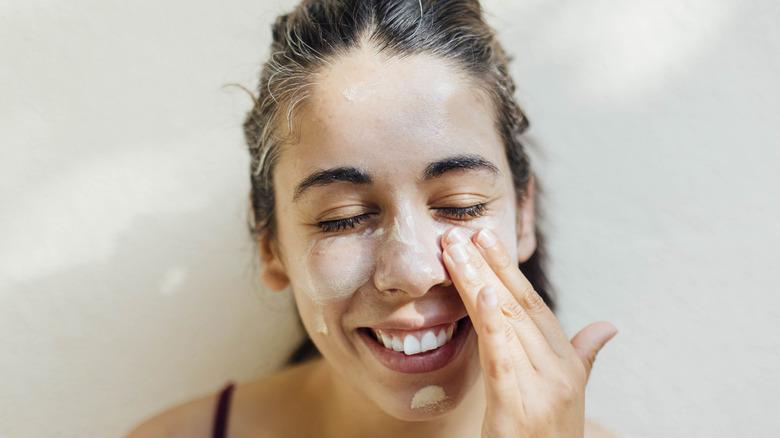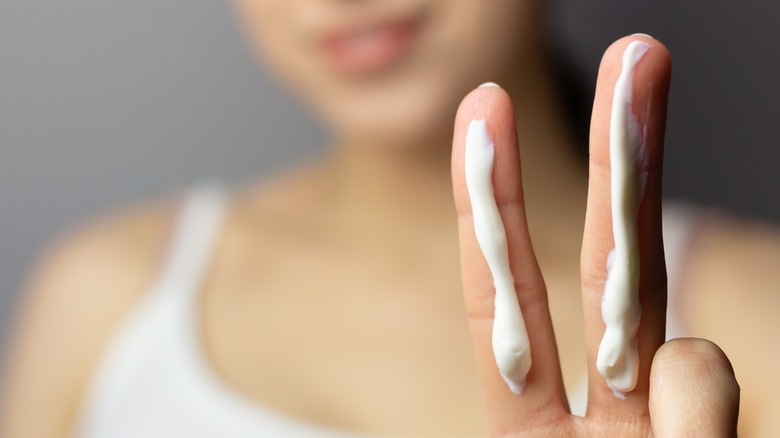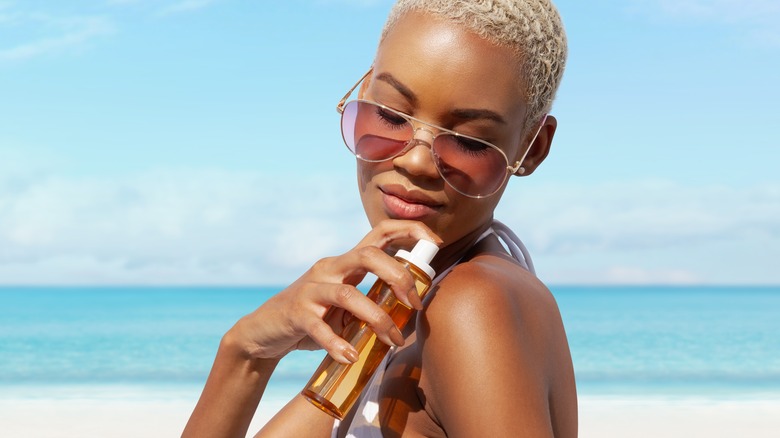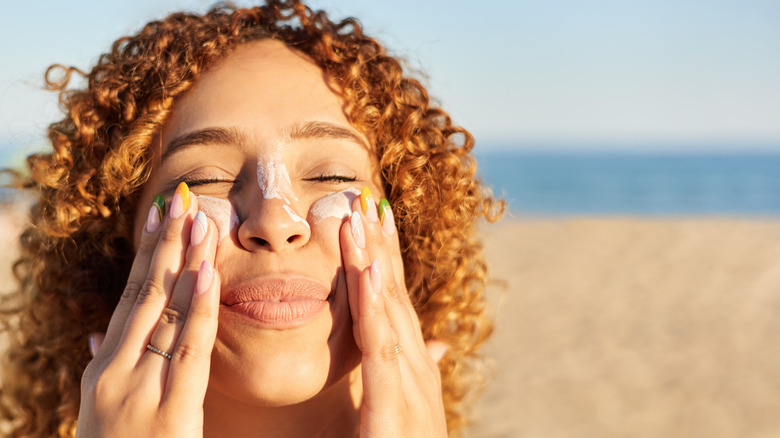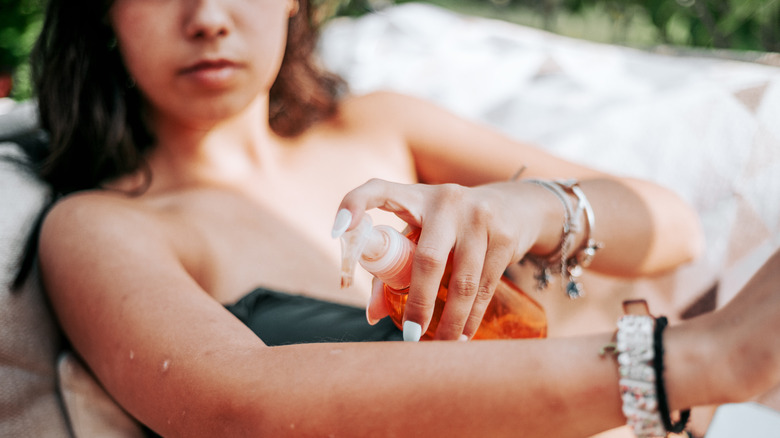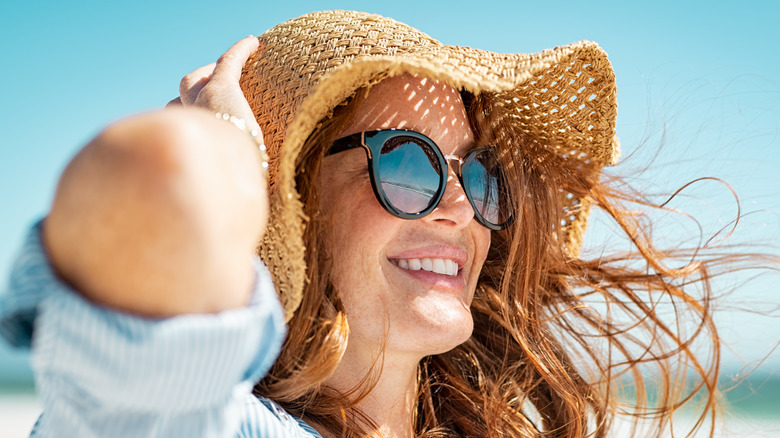Dermatologist Tells Us The Biggest Mistakes You're Making With Sunscreen
These days, it's no secret that sunscreen is an important daily step to defend our skin against UV rays, helping prevent certain types of cancer and other skin damage. However, a 2024 poll by Yahoo News found, shockingly, that only 12% of US adults use sunscreen every day — and a third of respondents never use sunscreen at all.
That's all bad enough, but it seems that even regular proponents of sunblock may not be reaping its full benefits. Putting on sun protection sounds simple, in theory: Just slather it on and go about your day, right? Unfortunately, it's not always that easy. In fact, many of us may be committing small but crucial errors with our sunscreen application.
To find out more, Glam spoke exclusively to dermatologist Dr. Hannah Kopelman. Dr. Kopelman has seen it all when it comes to skin cancer and diseases, and she knows exactly where most people fall flat in their fight against UV damage. From skipping crucial patches of skin to flubbing the necessary SPF, Dr. Kopelman walked us through the biggest mistakes we're making with our sunscreen.
Skimping on sunblock
Everyone loves to save a buck, but there are some things you don't want to be stingy about, and sunscreen is one of them. Still, many of us underestimate how much sun protection we really need to use. As Dr. Kopelman reveals to Glam, "One of the biggest mistakes I see people make with sunscreen is simply not applying enough." For your face, full coverage requires about half a teaspoon of sunscreen — enough to form a nickel-sized dollop or to cover the length of two fingers.
What about occasions where your whole body needs protection, like beach outings, sports games, or hikes? "You really need about a shot glass amount to cover your entire body properly," says Dr. Kopelman. "But most people use far less, leaving their skin under-protected." If you don't have a shot glass handy, this equates to roughly 3 tablespoons of sunscreen to adequately cover all your extremities. And if you've opted for a spray-on product, the American Academy of Dermatology recommends spraying until your skin glistens, using about an ounce per full-body application.
When in doubt, more is better. We know you're trying to avoid any white cast, but there's no need to skimp with hacks to help your SPF melt into your skin. After all, what's the point in even putting on sunscreen if there isn't enough to protect your precious complexion? Which brings us to our next point...
Leaving some skin exposed
Applying sunblock can be time-consuming and labor-intensive, but thoroughness is a must. Even if you hit all the major areas — face, chest, arms, legs, torso — you may be overlooking small but crucial stretches of skin that can quickly become holes in your sun defense. "Many people miss key areas, like the ears, neck, back of the hands, and feet," Dr. Kopelman advises Glam. "These spots are just as vulnerable to UV damage as the rest of your skin."
Indeed, the Skin Cancer Foundation reports that even minor, localized sunburns can add up over time and contribute to your overall risk of skin cancer. From the tips of your ears to the bottoms of your feet and even in odd spots like your eyelids — apparently, 5-10% of all skin cancers occur around your eyes! — the foundation seconds Dr. Kopelman's call for a more comprehensive and mindful approach to your sunscreen routine.
Note that this sunscreen coverage is important for everyone, no matter your skin tone. Melanated queens are also susceptible to damage from UV rays, and a study in the Journal of the American Academy of Dermatology even linked a lack of awareness to the notably higher incidence of dangerous late-stage melanoma in Black populations. No one is immune to the risks of sun exposure, so all ethnicities should take a proactive approach to skin protection and check-ups.
Thinking that sunscreen is a one-and-done process
If you're less outdoorsy and more indoorsy, you might think that including SPF in your get-ready routine is enough to cover you throughout the day. However, this isn't necessarily the case. Even in an office, school, or other enclosed space, UV rays can sneak in through windows, doors, and skylights, necessitating thoughtful sunblock reapplication. If you spend a lot of time outside or doing anything active, the need to top up your sunscreen becomes even more urgent. "Another common mistake is forgetting to reapply," Dr. Kopelman cautions Glam. "Sunscreen wears off with sweat, water, or just over time, so it's essential to reapply every two hours if you're outdoors."
Of course, this can feel a little awkward if you're, say, in the middle of your work day or glammed up for an outdoor event. But there are some tips for reapplying SPF over your makeup, such as using a cotton round to dab on fresh sunscreen without disturbing your aesthetic.
Picking an inadequate SPF
Even once you've perfected your sunblock application (and reapplication) technique, you must also ensure that the product itself is up to the challenge. "Using a sunscreen that's too low in SPF is another issue," Dr. Kopelman tells Glam. You might be thorough and conscientious about putting on your sun protection, but if your actual sunscreen isn't strong enough, you still might not be as safe as you think.
Of course, this raises the question: What do SPF numbers even mean, and which one should you use? "I always recommend SPF 30 or higher for effective protection," says Dr. Kopelman. This is in line with guidance from the American Academy of Dermatology, which also urges us to choose protection of at least SPF 30. On top of that, the ADA suggests reaching for a sunblock that is water-resistant and wide spectrum, meaning that it defends against both the UVA and UVB rays in sunlight.
In today's market, you even have the choice between chemical and mineral sunscreens. Mineral sunscreens, which often rely on zinc oxide or titanium oxide, create a reflective barrier between your skin and UV rays. They're often considered friendlier to sensitive complexions, but require constant reapplication and may leave a white cast. Meanwhile, chemical sunscreens use compounds like oxybenzone or octinoxate to absorb harmful sunlight. Lighter and more transparent, these sunscreens are easy to apply but can cause irritation, so don't be afraid to try out different options to find your perfect fit.
Going all-in on sunscreen and ignoring other skin-saving opportunities
Reliable sunscreen of SPF 30+? Check. Thoroughly covering all exposed skin? Check. Reapplying regularly? If you've made it this far, you're really winning at sunblock. But there's still one more major sun protection mistake that many of us make: Assuming that sunscreen is the only defense in our arsenal.
"People often rely too much on sunscreen and neglect other protective measures like wearing hats, sunglasses, or seeking shade during peak sun hours," Dr. Kopelman explains to Glam. While crucially important, she adds that "sunscreen is just one piece of the puzzle in preventing skin damage and reducing the risk of skin cancer."
When spending time outdoors, consider protective gear that's built with sun protection in mind. Certain hats, sunglasses, and long-sleeved shirts are crafted with extra UV protections that put them above and beyond your average options. Some research also suggests that diet can play a role in skin defense, with antioxidant-rich foods like green tea, berries, and grapes, boosting our endemic resistance to UV damage. Just bear in mind that these additional steps are meant to complement, not replace, a consistent sunscreen practice — SPF still holds a crucial place in your skincare regimen.
